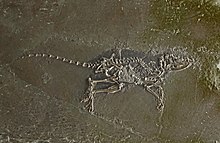Macrocranion
| Macrocranion Temporal range: Early Eocene
| |
|---|---|

| |
| M. tupaiodon in Staatliches Museum, Germany | |
| Scientific classification | |
| Domain: | Eukaryota |
| Kingdom: | Animalia |
| Phylum: | Chordata |
| Class: | Mammalia |
| Order: | Eulipotyphla |
| Family: | †Amphilemuridae |
| Genus: | †Macrocranion Weitzel, 1949 |
| Species[1] | |
| |
| Synonyms | |
| |
Macrocranion is a genus of extinct mammal from the Eocene epoch of Europe and North America.[2] Exceptional fossils have has been found in the Messel Pit of Germany.[3] Macrocranion species are often described as forest-floor predators, about the size of small squirrels but with longer limbs.[4] The genus is represented at the Messel Pit site by two species, M. tupaidon and M. tenerum.

M. tupaiodon had woolly fur with no spikes. Although possibly an omnivore, fossil remains indicate the specimen had eaten fish near the time of its death. This small animal was approximately fifteen cm in length, with long back legs capable of considerable speed.
The fossil of M. tenerum is five cm long. The species also had long legs for rapid movement, but its fur included a spiky protection. The long legs, however, indicate the animal couldn't have effectively rolled up for defense. Fossilized stomach remains show that M. tenerum's diet included ants, so it may have been an insectivore.
The oldest species are M. vandebroeki from the Paleocene-Eocene transition of Northern Europe and M. junnei from the Wasatchian (Early Eocene) of Wyoming.[5]
References[edit]
- ^ a b "Macrocranion general information". The Paleobiology Database. Retrieved 17 December 2021.
- ^ Rose, Kenneth D. (2006). The beginning of the age of mammals. Baltimore: Johns Hopkins University Press. ISBN 080189221X.
- ^ Maier, W. (1977). "Macrocranion tupaiodon Weitzel, 1949, - ein igelartiger Insektivor aus dem Eozän von Messel und seine Beziehungen zum Ursprung der Primaten". Journal of Zoological Systematics and Evolutionary Research. 15 (4): 311–318. doi:10.1111/j.1439-0469.1977.tb00544.x.
- ^ Maier, Wolfgang (1979). "Macrocranion tupaiodon, an adapisoricid (?) Insectivore from the Eocene of 'Grube Messel' (Western Germany)". Paläontologische Zeitschrift. 53 (1–2): 38–62. doi:10.1007/BF02987787. S2CID 84124639.
- ^ Smith, T.; Bloch, J. I.; Strait, S. G. & Gingerich, P. D. (2002). "New species of Macrocranion (Mammalia, Lipotyphla) from the earliest Eocene of North America and its biogeographic implications" (PDF). Contributions from the Museum of Paleontology, University of Michigan. 30 (14): 373–384.
![]() Media related to Macrocranion at Wikimedia Commons
Media related to Macrocranion at Wikimedia Commons
